Abhishek Satam and C.S.Panse*
Zoology Department
Maharshi Dayanand College of Arts, Science and Commerce,
Parel, Mumbai 400012
*pansechhaya@gmail.com
Abstract:
The abundance and diversity of zooplankton in relation to environmental parameters is necessary to assess the water quality. The studies of zooplankton at 2 sampling locations were identified around Vashi Creek area during pre-monsoon monsoon and post-monsoon season in the year 2013 to assess the water quality. Based on study of zooplankton, it appeared that the area is mostly preferred by copepods, Acetessp ,Lucifersp ,medusaectenophora, polychaetes, chaetognatha, decapods.
Plankton Biodiversity is highest in the coastal areas as there is variety of habitat near the coast. Copepods formed largest group of zooplankton population.
In general vashi creek sustain a rich plankton community. However recent industrial development along the banks of creek may create loss in diversity due to industrial waste disposal in to this creek ecosystem.
The best way to conserved biodiversity is to protect to habitat diversity which required periodic monitoring of this creek in order to compare with base line for checking loss of biodiversity
Key Words: Vashi Creek, Zooplankton
Introduction:
Planktons are a diverse group of organisms that live in the water column of large bodies of water and that cannot swim against a current. They provide a crucial source of food to many large aquatic organisms, such as fish and whales. Zooplanktons are one of the most important biotic components influencing all the functional aspects of an aquatic ecosystem such as food chain, food web, energy flow and cycling of matter (Dadhick and Saxena, 1999)
Zooplankton populations are useful indicators of food web stability. Study of zooplankton is necessary as they form vital link in pelagic food chain (Misra and Panigrahy, 1999) they contribute food of crustaceans, moluscs and fishes. Hence abundance of zooplankton acts as an index to assess fertility of water mass. The abundance and growth of zooplankton varies with seasons and water properties.
Vashi creek which is a part of Thane Creek and is adjacent to Mumbai harbour bay lies between latitude (19.02° N) and longitude (72.97°E). It is the ultimate recipient of all the liquid discharges from various industries. The discharges into this creek on its western side are dominated by Mumbai city sewerage and effluents from the industrial complexes, including the textile mills of south and central Mumbai, the petrochemical, fertilizer and thermal plants at Chembur and the pharmaceutical industries. The Vashi creek also shows presence of mangroves vegetation. Two sampling stations were selected for the study of Zooplankton. The present investigation id focused to find out zooplankton diversity with seasonal variation of Vashi creek.
Material and Method:
The study was undertaken from month of January 2013 to December 2013 Vashi creek. The sample for zooplanktons was collected from surface water by using plankton net with mesh size of 0.2 mm. The samples were preserved in 4% formalin solution and identified under microscope.
Observations:
Zooplankton Diversity:
Detailed study was carried out on the zooplankton diversity in Vashi creek. The groups belonging to zooplankton community is listed in table (Table: 1.1.1)
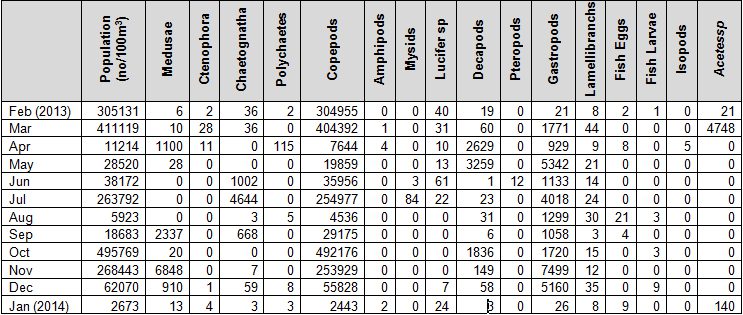
Table 1.1 : Monthly variation of zooplankton population no/100m3 in Vashi Creek (2013-2014)

Table 1.2 : Seasonal variation of zooplankton population no/100m3 in Vashi Creek (2013-2014)
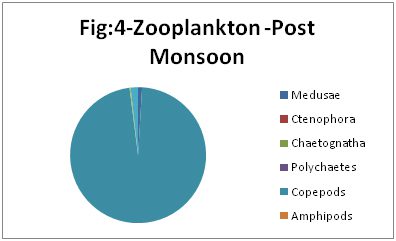
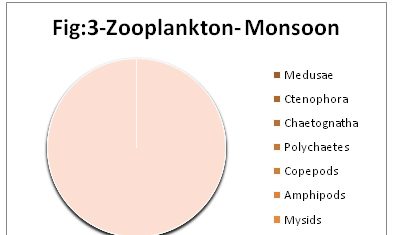
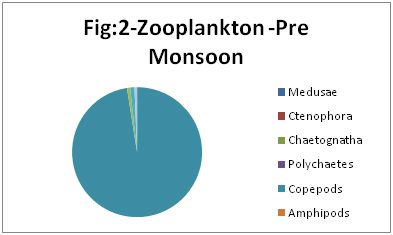
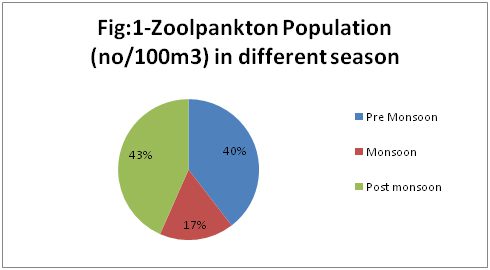
Result and Discussion:
Monthly data of zooplankton (no/100m3) in Vashi creek is shown in Table 1.1. Here the total monthly zooplankton density ranges from 2673 no/100m3 to 495769 no/100m3 and overall average of 249221 no/100m3 (2492.21 no/m3). The lowest was observed in the month of January 2014 and highest in October 2013. Goldin, 2001 reported average zooplankton density in range 902 to 492100 no/m3 and overall average 27917 no/m3 in Thane creek. Present data of zooplankton density shows significant reduction indicating pollution beyond tolerable limits. Similar reduction was in other estuaries and creeks such as Vellar estuary, Cochin back waters, Godavari estuary, Pitchavaram mangroves, Hooghly estuary etc.
Seasonal trend of total zooplankton in Vashi creek shows in Table 1.2 Average variation of different group of zooplankton number shows highest population was found in post monsoon season (43%) followed by pre monsoon (40%) and lowest in Monsoon (17%).
In post monsoon season copepods remains most dominant group contributing to 201094 no/100m3, followed by gastropods larvae 3601 no/100m3, medusae1948 no/100m3and isopods 0 no/100m3 (Fig.4). Similar observations were noted by L.R.Tiwari, Vijayalkshmi R, Nair,2002 in Dharamtar creek. Jadhav et.al, 2013 suggested high adaptive nature of copepods apparently favored its good proliferation among zooplankton community.
In pre monsoon season also copepods were most dominant contributing to 184212 no/100m3, followed by gastropods 2016 no/100m3, decapod larvae 1492 no/100m3, mysids and fish larvae 0 no/100m3(Fig 2)
In monsoon season also copepods were most dominant contributing to 81161 no/100m3, followed by gastropods 1877no/100m3, cheatognaths 1579 no/100m3,medusae 584 no/100m3 and ctenophore and isopods 0 no/100m3(Fig 3). In monsoon due to dilution effect there is fall in total Zooplankton population.
The zooplankton community structure in Vashi creek showed the dominance of copepods (Copepods > gastropods larvae >meduase> decapods larvae>Chaeatogaths>Acetessp). The irregular periodicity observed in the present study indicated no definite relationship with water and temperature. Normally the monsoon is associated with lower population densities due to its dilution effects and decreased photosynthetic activity by primary producers (Jadhav t.al 2013, Salve,Hiware 2010).
Conclusion:
Reduction in zooplankton biodiversity is due to anthropogenic activities near the shore especially the industrial development along the banks of Vashi creek. Continuous monitoring of Phyto and Zooplankton is necessary to check variation in diversity.
Acknowledgement:
The authors are grateful to the principal of MaharshiDayanand College Parel Mumbai for granting permission and providing facilities to conduct the studies at the college
Reference:
Dadhick N M.M. and Saxena 1999. Zooplankton as indicators of trophical status of some desert water near Bikaner. J.Environ. Pollut., 6: 251-254
L.R.Tiwari, Vijayalkshmi R, Nair,2002 Plankton biodiversity of Dharamtar creek and adjoining Mumbai harbor, Proc. National Seminar on creeks estuaries and mangroves- Pollution and conservation, 96:102.
Mishra S. and R.C. Panigrahy, 1999 Zooplankton ecology of Bahuda estuary (Orissa), east coast of India. Indian Journal of Marine sciences 28: 297-301.
R.N.Jadhav ,Mukesh Pimpliskar and Shruti Handa , 2013 Zooplankton diversity of Nirmal lake. Vasai Dis, Thane, India, J.Aqua.Biol.Vol.27(1), 1-6.
Salve, Balsaheb and Chadrashekhar Hiware, 2010. Zooplankton diversity of Wan reservoir, Nagpur (M.S.) India. Trends Res.in Sci.andTech.2(1):39-48






